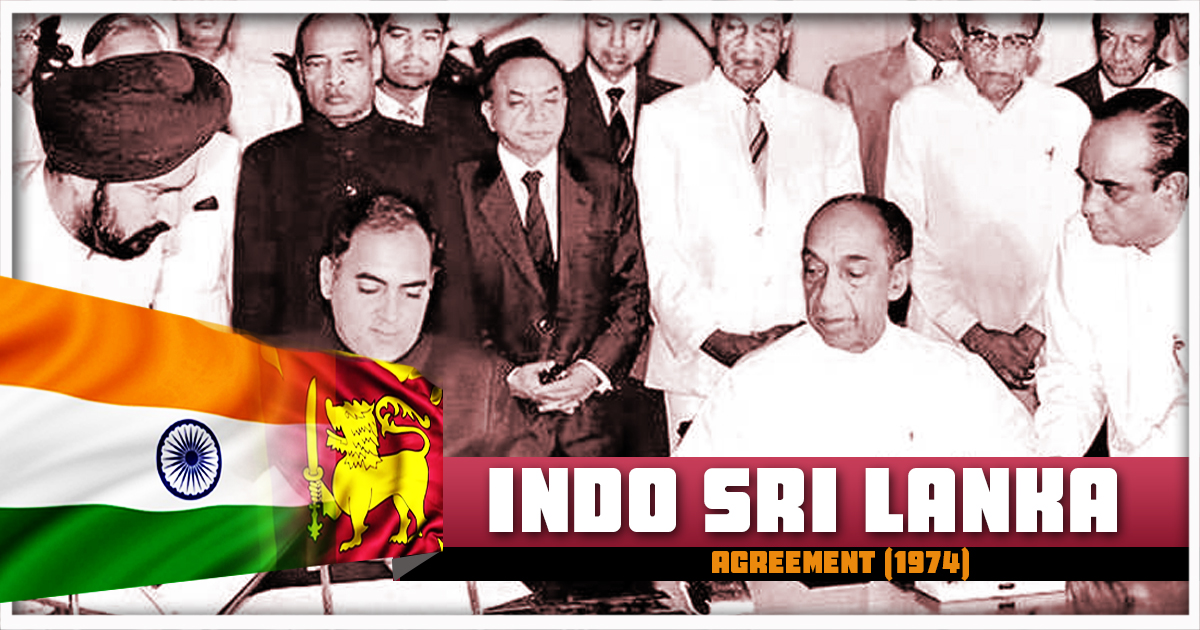
Introduction
The term “Katchatheevu” translates to “barren island” in the Tamil language. Situated in the Palk Strait, Katchatheevu Island spans approximately 285 acres and remains uninhabited. It lies between India and Sri Lanka, serving as a point of geographical significance in the region.
Katchatheevu Island
Located 33 km northeast of Rameswaram in Tamil Nadu, and approximately 62 km southwest of Sri Lanka’s Delft Island, Katchatheevu Island is a small, barren landmass. According to certain official records, it emerged as a result of a volcanic eruption in the 14th century, making it relatively young in geological terms. The island spans 1.6 km in length and is just 300 meters wide at its broadest point.
Katchatheevu Island was constructed in 1905 by Seenikuppan Padayachi, a merchant from Ramnad. It was intended to serve as a midpoint for Indian and Sri Lankan fishermen, providing a space for drying nets and seeking shelter during storms.
Features of Katchatheevu Island
Katchatheevu Island is unsuitable for permanent habitation due to the absence of a reliable source of drinking water. The sole structure on the island is St. Anthony’s Church, built in the early 20th century. Annually, a festival is held at the church where Christian priests from both India and Sri Lanka conduct services, attracting devotees from both countries.
While historically of little strategic significance, Katchatheevu Island has gained geopolitical importance in recent years due to China’s expanding influence in Sri Lanka. This shift in dynamics has made the island strategically valuable for India.
However, the island is also a source of contention, serving as an unofficial battleground between Indian Tamil fishermen and the Sinhaladominated Sri Lankan navy. This conflict arises from various factors, including overfishing in the Sethusamudram region, lingering tensions from the Sri Lankan civil war, and the unresolved Tamil question between the two countries.
The controversy surrounding Katchatheevu Island has led to both disputes and agreements between India and Sri Lanka.
Background of Katchatheevu Island Controversy:
During the early medieval period, Katchatheevu Island was under the control of the Jaffna kingdom in Sri Lanka. However, by the 17th century, authority over the island shifted to the Ramnad zamindari, centered in Ramanathapuram, approximately 55 km northwest of Rameswaram.
Subsequently, during the British Raj, Katchatheevu Island became part of the Madras Presidency, marking its incorporation into British colonial administration..
Katchatheevu Island Controversy:
In 1921, during the colonial era when both India and Sri Lanka were under British rule, there arose a dispute over the ownership of Katchatheevu Island, primarily to delineate fishing boundaries. A survey was initiated for this purpose. However, a British delegation from India contested the survey, asserting that the island was under the jurisdiction of the Ramnad kingdom.
Historically, Katchatheevu Island was indeed controlled by the kingdom of Ramanad Raja, a zamindari, from 1795 to 1803. This zamindari was situated in Ramanathapuram within the Madras Presidency, further adding to the complexity of ownership claims over the island.
IndoSri Lankan Maritime Agreement, 1974:
In 1974, Indian Prime Minister Indira Gandhi initiated efforts to resolve the maritime border dispute between India and Sri Lanka. As part of the agreement reached between the two countries, India effectively “ceded” Katchatheevu Island to Sri Lanka.
However, the agreement lacked clarity regarding the fishing rights of Indian fishermen in the waters surrounding Katchatheevu. This omission left the issue of fishing rights unresolved and became a source of contention between India and Sri Lanka, particularly concerning the livelihoods of Indian fishermen who traditionally relied on these waters for fishing.
Key Provisions of the IndoSri Lankan Maritime Agreement, 1974
Article 4
Sovereignty on Territory: Article 4 of the Agreement asserts that each State involved shall possess sovereignty, exclusive jurisdiction, and control over the waters, islands, continental shelf, and subsoil within their respective sides of the maritime boundary in the Palk Strait and Palk Bay.
This provision delineates the territorial rights of each State, affirming their exclusive authority over the specified areas within the maritime boundary.
Article 5
Access to Indian Fishermen: Article 5 of the agreement explicitly stated that Indian fishermen were granted access to Katchatheevu Island for various purposes, including resting, drying of nets, and participation in the annual St. Anthony’s festival.
Importantly, it specified that Indian fishermen would not be mandated by Sri Lanka to obtain travel documents or visas for these activities on the island.
This provision aimed to facilitate the traditional activities of Indian fishermen in the vicinity of Katchatheevu without imposing unnecessary bureaucratic hurdles.
Agreement of 1976:
In this agreement, both India and Sri Lanka delineated the maritime boundary in the Gulf of Mannar and the Bay of Bengal. It was stipulated that each country would exercise sovereign rights over the living and nonliving resources within their respective zones.
As part of the agreement, India secured exclusive rights over Wadge Bank, situated near Cape Comorin.
Furthermore, the agreement effectively ended the visits of Indian fishermen to Katchatheevu Island, as the island and its adjoining seas were acknowledged to naturally fall within Sri Lanka’s jurisdiction. This acknowledgment reinforced Sri Lanka’s authority over Katchatheevu Island and its surrounding waters.
Opposition to the Agreement:
The opposition to the agreement was widespread, encompassing various political parties such as the DMK, AIADMK, Jan Sangh, Swatantra, and the Socialist Party. These parties expressed strong opposition to the agreement for various reasons.
In 1991, the then Chief Minister of Tamil Nadu appealed to the central government to reclaim Katchatheevu Island and reinstate fishing rights for Tamil fishermen. Additionally, the Tamil Nadu Assembly passed a resolution demanding the retrieval of Katchatheevu Island.
This reflected the sentiment within Tamil Nadu, where there was a widespread desire to regain control over the island and restore the traditional fishing rights of Tamil fishermen.
Legal Status:
Despite protests and petitions aimed at reclaiming Katchatheevu Island, the Indian Supreme Court has upheld the validity of the 1974 agreement. In 2014, major political parties in Tamil Nadu, including the AIADMK and DMK, approached the Supreme Court seeking to declare the agreements of 1974 and 1976 null and void.
However, the Union Government has consistently stood by the validity of the agreements. In 2022, during discussions in the Rajya Sabha, the government reiterated that Katchatheevu Island falls within the jurisdiction of Sri Lanka according to the IndiaSri Lanka International Maritime Boundary Line.
The government also highlighted that the matter was under judicial review in the Supreme Court at the time.
Significance of the Signed Agreement
India’s decision regarding Katchatheevu Island can be viewed through various lenses, each highlighting different aspects of its significance and implications.
1. Safety and Strategic Considerations: India’s perceived loss of Katchatheevu Island was relatively minor compared to potential strategic and political threats originating from Sri Lankan territories and their allies.
2. Bilateral Relations: The 1974 agreement effectively addressed the maritime boundary dispute between India and Sri Lanka, fostering improved understanding and cooperation between the two nations. This contributed to strengthened bilateral relations.
3. Image Restoration: The cession of Katchatheevu Island allowed India to restore its image of diplomatic generosity, particularly following its involvement in the Bangladesh War of Liberation. This move reaffirmed India’s nationalistic outlook on the international stage.
4. Diplomatic Strategy: By ceding Katchatheevu Island, India strategically countered the colonialera divideandrule policy in the Indian Ocean region. This diplomatic masterstroke facilitated several key benefits:
Establishment of the Indian Ocean as a zone of peace amid increasing American and Soviet influences.
Maintenance of friendly relations with Sri Lanka in a region marked by growing volatility.
Reprioritization of Lankan Tamil expatriates and the facilitation of free mobility for Indian pilgrims and fishermen to Katchatheevu.
However, despite these perceived benefits, there remain several concerns and challenges associated with Katchatheevu Island that India needs to address. These may include issues related to sovereignty, maritime security, and the welfare of Indian fishermen operating in the region.
Detaining of Indian Fishing Vessels & Fishermen:
The frequent detention of Indian fishing vessels and fishermen from Tamil Nadu by Sri Lankan authorities remains a significant concern in the region.
Over the past two decades, a substantial number of Indian fishermen have been detained, and a considerable amount of fishing vessels have been seized by Sri Lanka. This ongoing issue highlights the challenges faced by Indian fishermen operating in the waters near Sri Lanka.
In a recent incident in 2022, a Sri Lankan court ordered 13 arrested Indian fishermen to pay a fine of Rs 10 million. Such hefty fines can pose a significant financial burden on the fishermen and exacerbate tensions between India and Sri Lanka over fishing rights in the region.
Resolving these disputes and ensuring the safety and wellbeing of Indian fishermen should be a priority for both countries to maintain peaceful relations and safeguard the livelihoods of those dependent on fishing.
Challenge of Livelihoods for Traditional Fishing Communities:
Katchatheevu Island has historically been a vital fishing area for traditional fishermen, but the ongoing dispute over its ownership has limited the movement of these communities along the coastal waters.
This restriction has made it challenging for them to maintain their way of life, affecting not only their livelihoods but also the overall economic stability of the region.
Impact on Religion & Cultural Values:
The controversy surrounding Katchatheevu Island has had significant ramifications on the cultural and religious fabric of the Indo Sri Lankan region. For instance, there has been a recent boycott of the annual two day festival at St. Anthony’s Church, triggered by the ongoing arrests of Indian fishermen by Sri Lankan authorities.
This boycott reflects the deep seated frustration and resentment felt by the local communities due to the unresolved disputes over fishing rights and territorial sovereignty, thereby highlighting the profound impact of the Katchatheevu Island controversy on cultural and religious sentiments in the region.
Threat of Chinese Aggression:
With the emergence of a more assertive China in recent years and its expanding activities abroad, analysts have raised concerns about the possibility of Chinese influence extending to Katchatheevu and the broader Palk Strait region.
The situation in Hambantota serves as a prime illustration of Sri Lanka’s susceptibility to Chinese involvement and influence in the area. This instance underscores the risks associated with foreign intervention and highlights the need to safeguard the sovereignty and stability of the region.
 Chinmaya IAS Academy – Current Affairs Chinmaya IAS Academy – Current Affairs
Chinmaya IAS Academy – Current Affairs Chinmaya IAS Academy – Current Affairs
